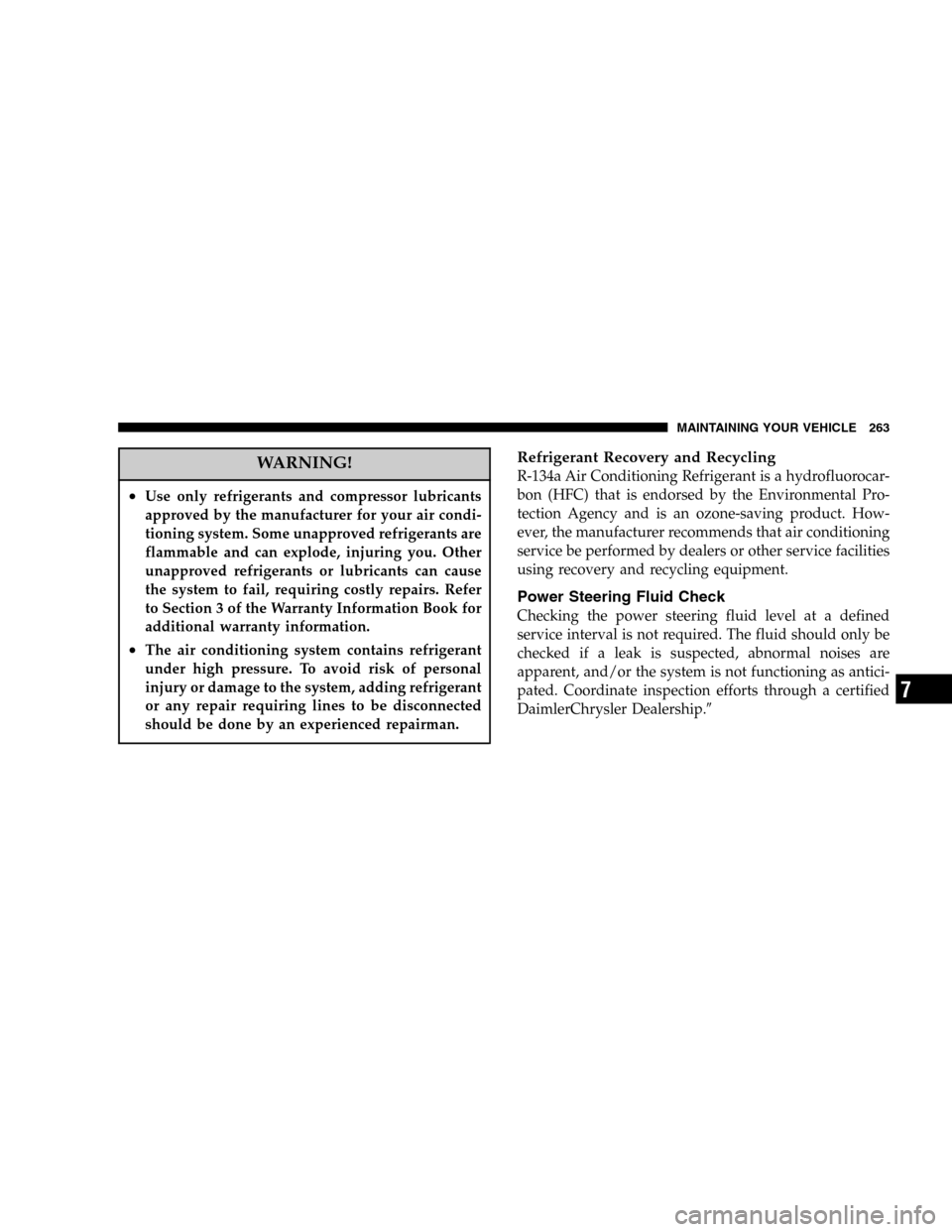Page 48 of 352

▫Parking Lights, Instrument Panel Lights, And
Headlights...........................62
▫Lights-On Reminder....................63
▫Headlight Dimmer Switch................63
▫Passing Light.........................63
▫Front Fog Lights — If Equipped............63
▫Turn Signals..........................63
▫Daytime Running Lights — Canada Only.....64
�Windshield Wipers And Washers.............64
▫Intermittent Wiper System................64
▫Windshield Wiper Operation..............65
▫Windshield Washers....................65
▫Mist Feature..........................65�Tilt Steering Column.....................66
�Electronic Speed Control...................66
▫To Activate...........................67
▫To Set At A Desired Speed................67
▫To Deactivate.........................67
▫To Resume Speed......................67
▫To Vary The Speed Setting................68
▫To Accelerate For Passing................68
�Electrical Power Outlet....................69
▫Electrical Outlet Use With Engine Off........70
�Cup Holders...........................70
�Storage...............................71
▫Glove Compartment....................71
48 UNDERSTANDING THE FEATURES OF YOUR VEHICLE
Page 149 of 352

RADIO GENERAL INFORMATION
Radio Broadcast Signals
Your new radio will provide excellent reception under
most operating conditions. Like any system, however, car
radios have performance limitations, due to mobile op-
eration and natural phenomena, which might lead you to
believe your sound system is malfunctioning. To help
you understand and save you concern about these “ap-
parent” malfunctions, you must understand a point or
two about the transmission and reception of radio sig-
nals.
Two Types of Signals
There are two basic types of radio signals... AM or
Amplitude Modulation, in which the transmitted sound
causes the amplitude, or height, of the radio waves to
vary... and FM or Frequency Modulation, in which the
frequency of the wave is varied to carry the sound.
Electrical Disturbances
Radio waves may pick up electrical disturbances during
transmission. They mainly affect the wave amplitude,
and thus remain a part of the AM reception. They
interfere very little with the frequency variations that
carry the FM signal.
AM Reception
AM sound is based on wave amplitude, so AM reception
can be disrupted by such things as lightning, power lines
and neon signs.
FM Reception
Because FM transmission is based on frequency varia-
tions, interference that consists of amplitude variations
can be filtered out, leaving the reception relatively clear,
which is the major feature of FM radio.
NOTE:On vehicles so equipped the radio, steering
wheel radio controls and 6 disc CD/DVD changer will
UNDERSTANDING YOUR INSTRUMENT PANEL 149
4
Page 200 of 352

WARNING!
To help avoid personal injury, follow these tips:
•Never reach through the steering wheel to operate
steering column controls. Injury to your hands or
loss of vehicle control may result.
•If the engine stalls or power assist fails due to a
malfunction, vehicle steering and braking will
require greater effort.
ANTI-LOCK BRAKE SYSTEM — IF EQUIPPED
The Anti-Lock Brake System is designed to aid the driver
in maintaining vehicle control under adverse braking
conditions. The system operates with a separate com-
puter to modulate hydraulic pressure to prevent wheel
lock-up and help avoid skidding on slippery surfaces.All vehicle wheels and tires must be the same size and
type and tires must be properly inflated to produce
accurate signals for the computer.
WARNING!
Significant over or under-inflation of tires, or mixing
sizes of tires or wheels on the vehicle can lead to loss
of braking effectiveness.
The Anti-Lock Brake System conducts a low speed self-
test at about 12 mph (20 km/h). If for any reason, your
foot is on the brake when the vehicle reaches 12 mph (20
km/h), this check will be delayed until 25 mph (40
km/h).
The Anti-Lock Brake System pump motor runs during
the self-test and during an ABS stop to provide the
200 STARTING AND OPERATING
Page 206 of 352

After Driving Off-Road
Off-road operation puts more stress on your vehicle than
does most on-road driving. After going off-road it is
always a good idea to check for damage. That way you
can get any problems taken care of right away and have
your vehicle ready when you need it.
•Completely inspect the underbody of your vehicle.
Check tires, body structure, steering, suspension, and
exhaust system for damage.
•Check threaded fasteners for looseness, particularly on
the chassis, drivetrain components, steering, and sus-
pension. Retighten them, if required, and torque to the
values specified in the Service Manual.
•Check for accumulations of plants or brush. These
things could be a fire hazard. They might hide damage
to fuel lines, brake hoses, axle pinion seals, and
propeller shafts.
•After extended operation in mud, sand, water, or
similar dirty conditions, have brake rotors, wheels,
brake linings, and axle yokes inspected and cleaned as
soon as possible.
WARNING!
Abrasive material in any part of the brakes may
cause excessive wear or unpredictable braking. You
might not have full braking power when you need it
to prevent an accident. If you have been operating
your vehicle in dirty conditions, get your brakes
checked and cleaned as necessary.
•If you experience unusual vibration after driving in
mud, slush or similar conditions, check the wheels for
impacted material. Impacted material can cause a
wheel imbalance and freeing the wheels of it will
correct the situation.
206 STARTING AND OPERATING
Page 246 of 352

▫Air Conditioner Maintenance.............262
▫Power Steering Fluid Check..............263
▫Driveline And Steering Component
Lubrication..........................264
▫Body Lubrication.....................264
▫Windshield Wiper Blades................265
▫Windshield Washers...................265
▫Exhaust System......................266
▫Cooling System.......................266
▫Hoses And Vacuum/Vapor Harnesses.......271
▫Brake System........................272
▫Automatic Transmission................274
▫Hydraulic Clutch Fluid — Manual
Transmission........................276▫Manual Transmission..................276
▫Transfer Case........................277
▫Front/Rear Axle Fluid..................278
▫Appearance Care And Protection From
Corrosion...........................279
�Fuse Panel...........................286
▫Interior Fuses........................286
▫Underhood Fuses
(Power Distribution Center)..............288
�Vehicle Storage........................290
�Replacement Bulbs — If Equipped...........290
�Bulb Replacement......................291
▫Head Light..........................291
▫Front Park/Turn Signal.................292
246 MAINTAINING YOUR VEHICLE
Page 263 of 352

WARNING!
•Use only refrigerants and compressor lubricants
approved by the manufacturer for your air condi-
tioning system. Some unapproved refrigerants are
flammable and can explode, injuring you. Other
unapproved refrigerants or lubricants can cause
the system to fail, requiring costly repairs. Refer
to Section 3 of the Warranty Information Book for
additional warranty information.
•The air conditioning system contains refrigerant
under high pressure. To avoid risk of personal
injury or damage to the system, adding refrigerant
or any repair requiring lines to be disconnected
should be done by an experienced repairman.
Refrigerant Recovery and Recycling
R-134a Air Conditioning Refrigerant is a hydrofluorocar-
bon (HFC) that is endorsed by the Environmental Pro-
tection Agency and is an ozone-saving product. How-
ever, the manufacturer recommends that air conditioning
service be performed by dealers or other service facilities
using recovery and recycling equipment.
Power Steering Fluid Check
Checking the power steering fluid level at a defined
service interval is not required. The fluid should only be
checked if a leak is suspected, abnormal noises are
apparent, and/or the system is not functioning as antici-
pated. Coordinate inspection efforts through a certified
DaimlerChrysler Dealership.�
MAINTAINING YOUR VEHICLE 263
7
Page 272 of 352

are present. Components should be replaced immedi-
ately if there is any evidence of degradation that could
cause failure.
Brake System
In order to assure brake system performance, all brake
system components should be inspected periodically.
Refer to the appropriate “Maintenance Schedule” in
Section 8 for suggested service intervals.
WARNING!
Riding the brakes can lead to brake failure and
possibly an accident. Driving with your foot resting
or riding on the brake pedal can result in abnormally
high brake temperatures, excessive lining wear, and
possible brake damage. You wouldn’t have your full
braking capacity in an emergency.
Brake and Power Steering System Hoses
When servicing the vehicle for scheduled maintenance,
inspect surface of hoses for evidence of heat and me-
chanical damage. Hard and brittle rubber, cracking, tears,
cuts, abrasion, and excessive swelling suggest deteriora-
tion of the rubber. Particular attention should be made to
examining those hose surfaces nearest to high heat
sources, such as the exhaust manifold.
Inspect all hose clamps and couplings to make sure they
are secure and no leaks are present.
NOTE:Inspection of brake hoses should be done when-
ever the brake system is serviced and every engine oil
change.
272 MAINTAINING YOUR VEHICLE
Page 298 of 352
Component Fluid, Lubricant, or Genuine Part
Brake Master Cylinder Mopar�DOT 3 Brake Fluid, SAE J1703 should be used. If DOT 3, SAE J1703
brake fluid is not available, then DOT 4 is acceptable. Use only recom-
mended brake fluids.
Power Steering Reservoir Mopar�ATF+4 Automatic Transmission Fluid or equivalent.
Steering Gear & Linkage, Ball
Joints, Prop Shafts & Yokes, Wheel
BearingsMopar�Multi-Purpose Grease NLGI Grade 2 EP, GC-LB or equivalent.
298 MAINTAINING YOUR VEHICLE